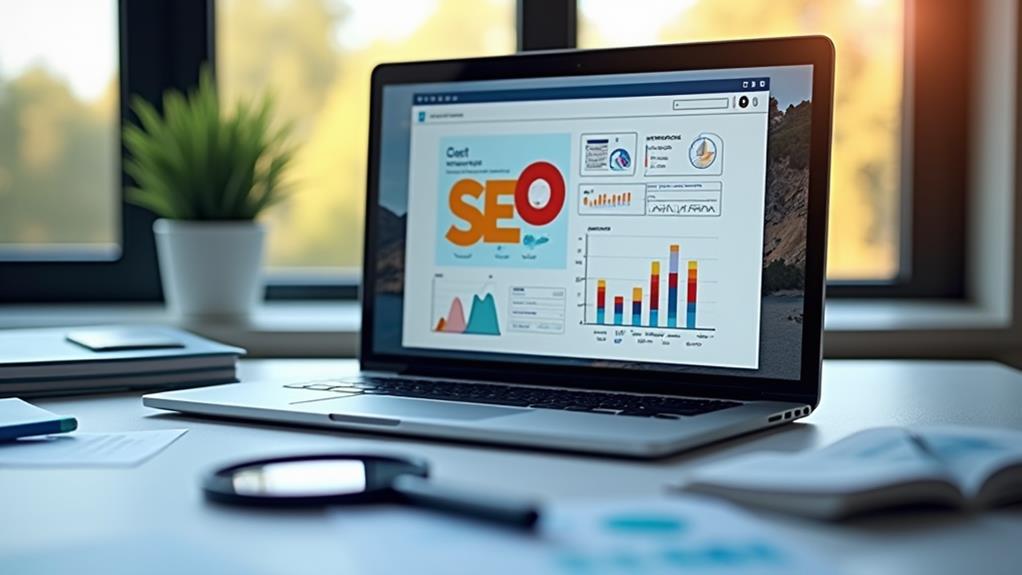Small business owners must prioritize five essential on-page SEO factors for improved visibility and organic traffic. First, optimizing title tags with relevant keywords boosts search engine relevance. Second, high-quality, regularly updated content enhances expertise and trustworthiness. Third, a superior user experience through effective navigation and swift load speeds reduces bounce rates. Fourth, strategic internal linking improves site engagement and search engine crawlability. Finally, mobile optimization, via responsive design and fast load times, is crucial as mobile searches surpass 60%. By concentrating on these areas, businesses can greatly enhance their search performance and uncover further strategies to uplift their digital presence.
Key Takeaways
- Optimize title tags with relevant keywords and include your brand name to enhance search visibility and recognition.
- Ensure high-quality content that demonstrates expertise, authority, and trustworthiness to engage users and improve SEO.
- Enhance user experience by optimizing website navigation, load speed, and mobile-friendliness to reduce bounce rates.
- Implement a robust internal linking strategy to improve site navigation and support search engine crawlability.
- Focus on mobile optimization with responsive design and fast loading speeds to retain users and improve search rankings.
Optimize Title Tags
Why is refining title tags important for small business owners aiming to enhance their on-page SEO? Title tags are essential in influencing search engine visibility and relevance, serving as one of the key ranking factors.
For small business owners, conducting thorough keyword research is fundamental. By incorporating relevant target keywords within the title tag, businesses can greatly enhance their search engine visibility. This approach guarantees that the title is aligned with user search intent, leading to better positioning on search engine results pages (SERPs).
Furthermore, adhering to Google's recommendation of keeping title tags under 60 characters is critical. This ideal title length prevents truncation in search results, ensuring complete visibility to users and preserving the intended message.
In addition, including the brand name at the end of the title tag can improve brand recognition without detracting from the page's primary content focus.
A/B testing different title tags is a data-driven approach that can greatly impact click-through rates (CTRs). By evaluating which variations attract more visitors, businesses can refine their titles to boost performance.
Consequently, optimizing title tags is a strategic move that can enhance visibility, improve rankings, and drive traffic effectively.
Improve Content Quality
Optimizing title tags is a foundational step towards improving on-page SEO, but to truly capitalize on search engine visibility, enhancing content quality is crucial. High-quality content must showcase expertise, authority, and trustworthiness (E-A-T), which are essential in Google's evaluation, especially for sensitive YMYL topics. This can be achieved by maintaining content freshness through regular updates, guaranteeing the information remains accurate and relevant. Such practices not only attract more organic traffic but also improve search rankings.
Utilizing extensive content strategies that thoroughly address user queries aligns with search intent, a critical factor for performance in search results. Employing keyword research tools to identify relevant keywords and semantically related phrases guarantees content aligns with what users are actively searching for. This data-driven approach boosts the likelihood of meeting user needs effectively.
Furthermore, multimedia integration, including images and videos, is crucial in boosting user engagement and retention. These elements make content more appealing and informative, increasing the time users spend on a page. Such factors contribute substantially to a page's overall SEO effectiveness, reinforcing the importance of content quality in on-page optimization efforts.
Enhance User Experience
To truly improve user experience, prioritizing website structure and navigation is vital. A well-structured website not only reduces bounce rates but also fosters improved user engagement, which is essential for boosting SEO rankings.
Key strategies to enhance user experience include:
- Optimize Page Load Speed: Research indicates that a one-second delay can result in a 7% drop in conversions and increase bounce rates by 32%. Ensuring swift page loading is necessary for retaining visitors and improving user satisfaction.
- Ensure Mobile-Friendliness: With over 60% of all searches occurring on mobile devices, adopting a responsive design is non-negotiable. Mobile-friendly sites are more likely to engage users effectively and rank higher in search results, enhancing overall site accessibility.
- Leverage User Feedback: Gathering and analyzing user feedback provides insights into potential areas of improvement. By addressing user concerns and enhancing site features, businesses can greatly improve the user experience.
High-quality, user-centric content that addresses audience needs can extend dwell times, further improving SEO performance.
Utilize Internal Linking
Internal linking's importance in on-page SEO cannot be overstated, as it plays an essential role in enhancing website navigation by seamlessly connecting related content. This practice not only facilitates user access to information, encouraging prolonged site engagement, but also strategically distributes page authority across your website.
By signaling link relevance to search engines, internal links assist in boosting the search rankings of linked pages, thereby enhancing overall site visibility.
Utilizing descriptive anchor text is vital in internal linking. It improves contextual relevance by providing users and search engines with explicit indications of the linked page's content. This practice helps in guiding the user's journey through your site with clarity and precision, while simultaneously offering search engines insights into page topics and relationships.
Regular audits of your internal linking structure are essential. Ensuring that links are functional and direct users to pertinent, updated content reduces bounce rates and enhances user experience.
A robust internal linking strategy also supports better crawlability, enabling search engines to index your site efficiently. This thorough approach to internal linking not only improves navigation but greatly bolsters your on-page SEO performance.
Focus on Mobile Optimization
In today's digital landscape, mobile optimization's significance cannot be overstated, as it directly impacts user retention and search engine rankings.
With 61% of users unlikely to revisit a non-mobile-friendly site, responsive design is not merely a choice but a necessity.
Google's mobile-first indexing underscores the importance of mobile optimization by prioritizing the mobile version of content for indexing and ranking.
Hence, businesses must guarantee their websites are optimized for mobile to maintain search visibility and user engagement.
Consider the following critical steps to enhance mobile optimization:
- Responsive Design: Implement a responsive design that seamlessly adapts to various screen sizes, providing an ideal viewing experience across all devices.
- Mobile Speed: Focus on mobile speed by optimizing images and reducing file sizes, as 53% of mobile visitors abandon sites that load in over three seconds.
- Accelerated Mobile Pages (AMP): Utilize AMP to greatly improve mobile load times, offering a streamlined experience that can enhance both rankings and user engagement.
Frequently Asked Questions
What Are Essential SEO Guidelines for Website Owner?
To enhance a website's search engine performance, prioritize keyword research to identify relevant terms, implement content optimization by integrating these keywords naturally, and maintain precise meta descriptions and title tags to improve visibility and user engagement.
Which of the Following Is an Important Factor for on Page SEO?
An important factor for on-page SEO is keyword placement. Proper content optimization involves strategically positioning target keywords within title tags, meta descriptions, URLs, and internal links to enhance search engine visibility and improve user experience.
Which Are the Important Factors of SEO?
To enhance SEO, essential factors include keyword research for identifying high-ranking terms, and content optimization to guarantee relevance and engagement. These strategies, coupled with technical elements like mobile optimization and internal linking, drive superior search engine performance.
What Are the 3 Most Important on Page SEO Factors?
The three most important on-page SEO factors are keyword optimization, content quality, and title tags. Effective keyword optimization enhances search visibility, quality content boosts user engagement, and well-crafted title tags improve click-through rates, collectively enhancing search engine rankings.
Conclusion
To summarize, mastering on-page SEO is imperative for small business success in digital landscapes. Optimizing title tags greatly enhances search visibility, while high-quality content remains a cornerstone for engagement and authority. Improvement of user experience through streamlined navigation and site speed directly correlates with reduced bounce rates. Internal linking effectively distributes link equity, enhancing page relevance. Finally, prioritizing mobile optimization is essential, given the increasing mobile user base, ensuring accessibility and improving search rankings across all platforms.




